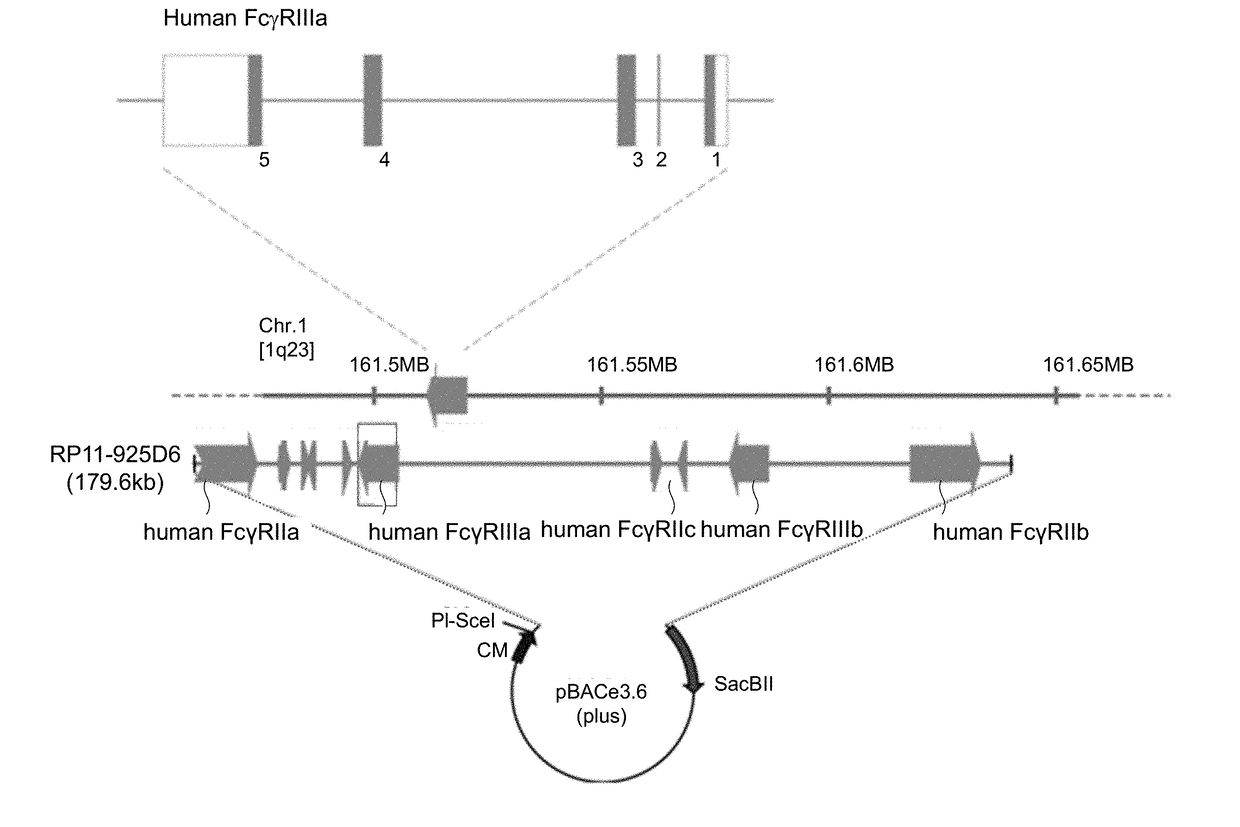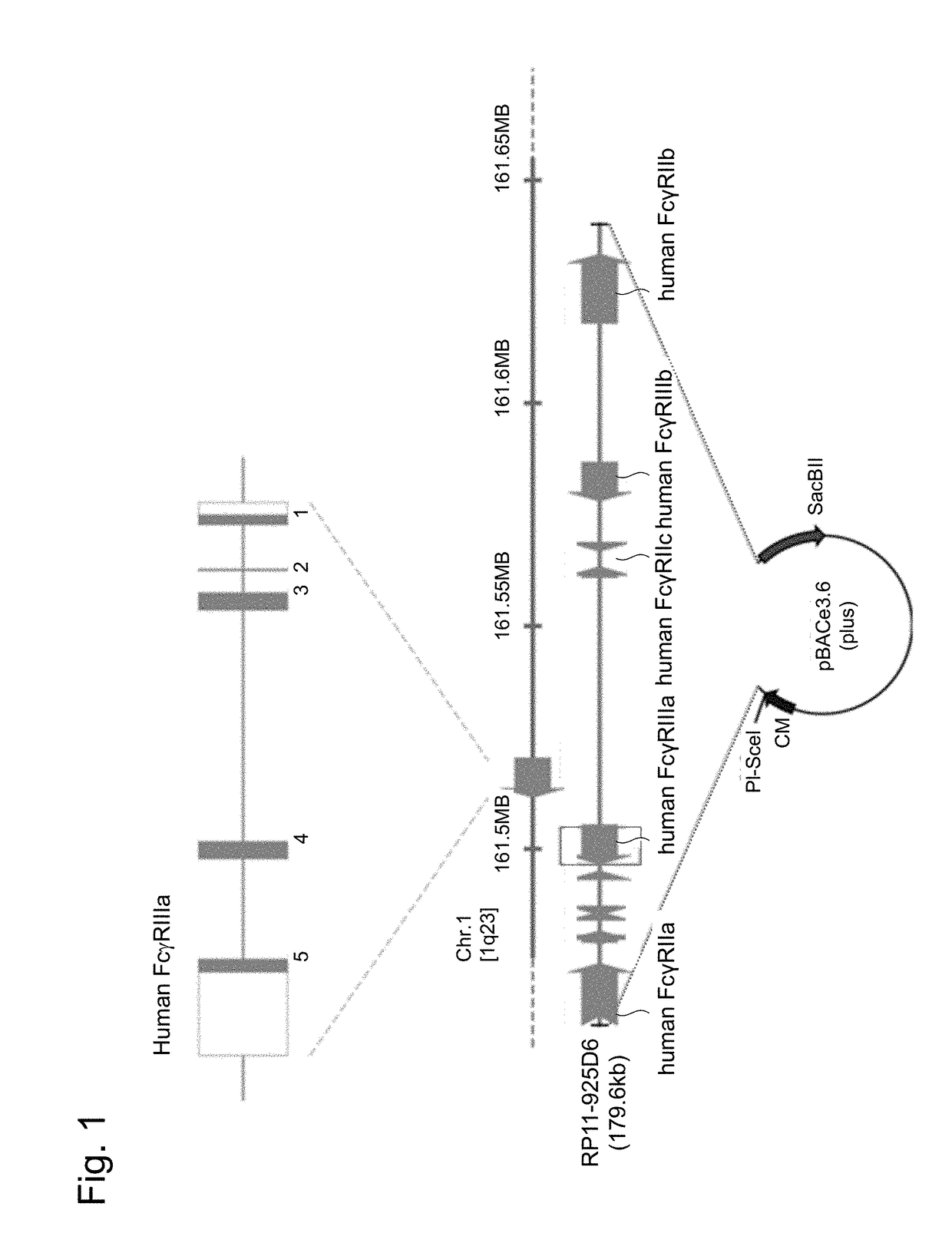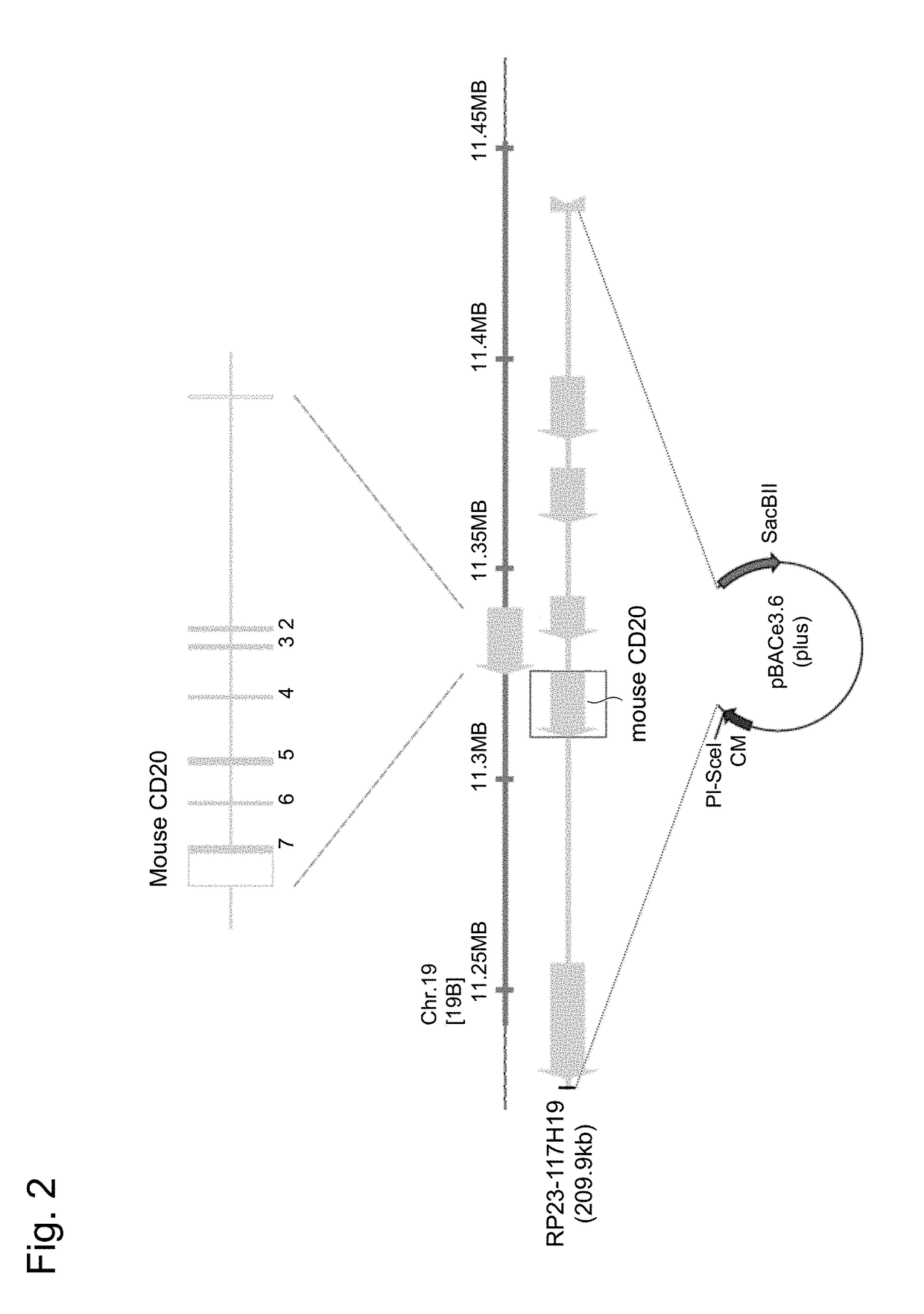TRANSGENIC NON-HUMAN ANIMAL EXPRESSING HUMAN SPECIFIC MOLECULE AND HUMAN FCy RECEPTOR FAMILY
a technology of which is applied in the field of transgenic nonhuman animal expressing human specific molecule and human fcy receptor family, can solve the problems of high drug price, inability to make an appropriate evaluation of the safety or pharmacological effect of such a targeted drug to a human molecule, and the ethical and welfare viewpoints are extremely restricted for animal experiments using non-human primates
- Summary
- Abstract
- Description
- Claims
- Application Information
AI Technical Summary
Benefits of technology
Problems solved by technology
Method used
Image
Examples
example 1
of BAC Comprising Gene Cluster of Human Fcγ Receptor Family
[0069]Based on the cDNA sequences of human FcγRIIa, IIb, IIc, IIIa and IIIb genes (GenBank: BC019931, BC031992, BC137397, BC017865 and BC128562), human genomic sequences were searched by using UCSC Genome Browser, and a BAC clone including the gene cluster encoding all receptors of the human Fcγ receptor family was screened for. As a result, RP11-925D6 with a size of 179.6 kb, which included all of the genomic DNA sequences of the human FcγRIIa, IIb, IIc, IIIa and IIIb genes, was identified and acquired (Advanced Geno Techs Co.), and this was used as a BAC expression vector for the gene cluster of the human Fcγ receptor family (FIG. 1).
example 2
of BACs Comprising Genomic Sequences of Human CD20 and Mouse CD20 Genes
[0070]Based on the cDNA sequence of the mouse CD20 gene (GenBank: BC028322), a mouse genomic DNA sequence was searched using UCSC Genome Browser. As a result, it was found that the mouse CD20 gene is present in the 198.19 cM region of chromosome 19. The cDNA sequence of the mouse CD20 gene was aligned together with the mouse genomic sequence, and as a result, it was revealed that the coding region of the mouse CD20 gene also encodes the 15-kb genomic sequence comprising 7 exons.
[0071]Subsequently, a BAC clone encoding the mouse CD20 gene locus was screened for, and as a result, RP23-117H19 (FIG. 2) that is a BAC clone, which covers 209.9 kb of chromosome 19 comprising a 111-kb genomic sequence at the 5′-upstream and a 83-kb genomic sequence at the 3′-downstream, as well as the genomic DNA sequence of the mouse CD20 gene locus, was identified and acquired (Advanced Geno Techs Co.). From the aforementioned gene inf...
example 3
ion of Recombinant BAC Expression Vector for Human CD20 Gene
[0073]Upon construction of a recombinant BAC expression vector for the human CD20 gene, the sequence of intron 4 of the human CD20 gene, the sequences of both termini of the human CD20 gene genomic DNA sequence of from the translation start codon of the human CD20 gene to the translation start codon of the same, and the 3′-terminus and 5′-terminus of the mouse CD20 gene genomic DNA sequence of from the translation start codon of the mouse BAC clone CD20 gene to the stop codon of the same, as shown below, were used as key sequences for an active homologous recombination reaction in Escherichia coli.
CD20-H1:(SEQ ID NO: 1)5′-ATGACAACAC CCAGAAATTC AGTAAATGGG ACTTTCCCGGCAGAGCCAAT-3′CD20-H2:(SEQ ID NO: 2)5′-CTCCCCAAGATCAGGAATCCTCACCAATAGAAAATGACAGCTCTCCTTAA-3′CD20-H3:(SEQ ID NO: 3)5′-CCTAGACATTTAGACTAGATAGCAAGATGTTTTGGAAAGCAAGAGGCAGC-3′CD20-H4:(SEQ ID NO: 4)5′-AGGAACATCCACTTCCATCTACCCCTTCTTGCTTACAATTCTGTTTGGTT-3′CD20-H5:(SEQ ID N...
PUM
| Property | Measurement | Unit |
|---|---|---|
| Cytotoxicity | aaaaa | aaaaa |
| Biodistribution | aaaaa | aaaaa |
Abstract
Description
Claims
Application Information
 Login to View More
Login to View More - R&D
- Intellectual Property
- Life Sciences
- Materials
- Tech Scout
- Unparalleled Data Quality
- Higher Quality Content
- 60% Fewer Hallucinations
Browse by: Latest US Patents, China's latest patents, Technical Efficacy Thesaurus, Application Domain, Technology Topic, Popular Technical Reports.
© 2025 PatSnap. All rights reserved.Legal|Privacy policy|Modern Slavery Act Transparency Statement|Sitemap|About US| Contact US: help@patsnap.com



